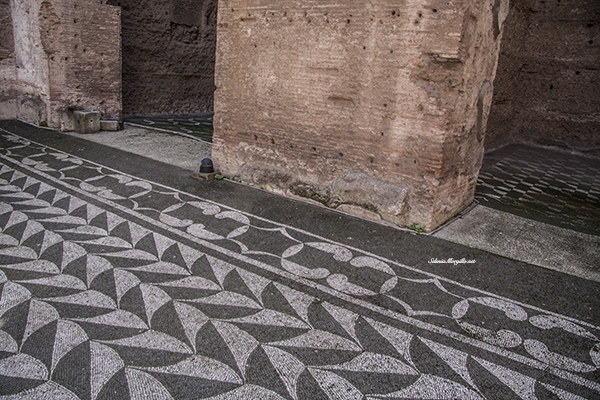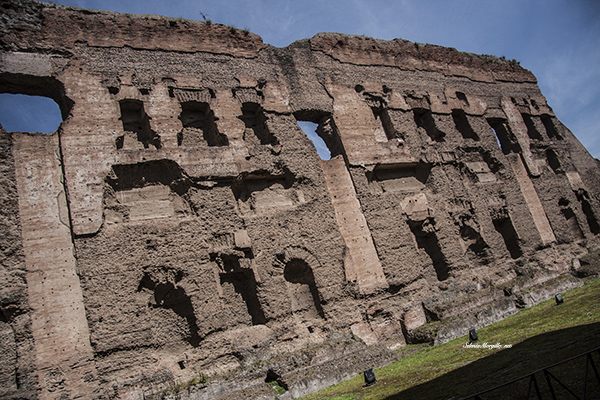Caracalla’s Bath in Rome
(Italian Version below*)
The Caracalla’s Bath represents one of the best-preserved thermal plants in Rome. It was inaugurated in 216 AD by Emperor Caracalla, son of Septimius Severus, in a peripheral area between the junction of Via Capena and the slopes of the Little Aventine.
The architecture expresses the maximum ingenuity of the Romans in the forms of Caracalla.
It is a perfectly oriented thermal system to take advantage of the sun’s radiation: it is composed of a central axis on which the natatio (outdoor pool), the frigidarium, the tepidarium, and the caldarium open, and symmetrical rooms placed laterally, the changing rooms, gyms, laconicum (saunas). Impressive are the “ruins” which in some places still reach 37 meters in height.
The baths of Caracalla hosted between 6000/8000 people a day and, almost certainly, the entrance was free.
There was no division of the sexes, so that men and women could attend the facility at the same times. If at first, the Romans had a negative idea of water, associated with the “softening of the body”, over the centuries they understood its importance and made it the mainstay of their days.
The spas became a social gathering place, a cultural exchange, they hosted libraries (as in the case of Caracalla), tabernae, gyms, areas for massages and depilation.
The Caracalla plant was known throughout Rome for the pomp of its marble decorations, glass pastes and for its admirable sculptures.
From here come the so-called Toro Farnese exhibited at the Archaeological Museum of Naples or the famous mosaics with the athletes housed in a section of the Vatican Museums.
With the fall of the Roman Empire in 476 AD and the cutting of the aqueducts in 537 AD by Vitige, the area was completely abandoned; used at first as a cemetery, it later became a quarry of materials and was completely stripped.
The first “excavations” were the work of Paolo III Farnese, in the middle of the Renaissance, who thus began to collect and form the nucleus of the collection that has the name of the family (the Farnese collection is an integral part of the Archaeological Museum of Naples).
In the nineteenth century, the area was investigated again to reach the twentieth century and the present day.
For a long time, the Baths of Caracalla were imprisoned by the scenographies and metal structures of the Opera House.
In 2001 the Baths of Caracalla were reopened to classical music and opera, with a temporary and removable stage, away from the structures of the Caldarium and respecting the monument. The merit of the rebirth and the desire to make the whole world known a unique structure of its kind belongs to the Director Marina Piranomonte.
InfoSite and Ticket: CoopCulture
All rights reserved*
Le Terme di Caracalla rappresentano l’impianto termale tra i meglio conservati a Roma. Fu inaugurato nel 216 d.C. dall’Imperatore Caracalla, figlio di Settimio Severo, in una zona periferica tra lo snodo di Via Capena e le pendici del Piccolo Aventino.
L’architettura esprime nelle forme di Caracalla il massimo ingegno dei Romani. E’ un impianto termale perfettamente orientato per sfruttare l’irraggiamento del sole: è composto da un’asse centrale su cui si aprono la natatio (piscina scoperta), il frigidarium, il tepidarium ed il caldarium e da ambienti simmetrici posti lateralmente, gli spogliatoi, le palestre, i laconicum (le saune).
Impressionano i “ruderi” che in alcuni punti raggiungono ancora i 37 metri di altezza.
Le terme di Caracalla ospitavano tra le 6000/8000 persone al giorno e, quasi sicuramente, l’ingresso era gratuito.
Non c’era una divisione dei sessi, così che gli uomini e le donne potevano frequentare la struttura nei medesimi orari. Se in un primo momento i Romani avevano un’idea negativa dell’acqua, associata al “rammollimento del corpo”, nel corso dei secoli ne capirono l’importanza e ne fecero il perno delle loro giornate.
Le terme divennero un luogo di ritrovo sociale, di scambio culturale, ospitavano biblioteche (come nel caso di Caracalla), tabernae, palestre, zone per massaggi e per la depilazione.
L’impianto di Caracalla era noto in tutta Roma per lo sfarzo delle decorazioni in marmo, paste vitree e per le mirabili sculture. Da qui provengono il c.d. Toro Farnese esposto al Museo archeologico di Napoli o i celebri mosaici con gli atleti ospitati in una sezione dei Musei Vaticani.
Con la caduta dell’impero Romano nel 476 d.C. ed il taglio degli acquedotti nel 537 d.C. ad opera di Vitige, l’area fu completamente abbandonata; utilizzata in un primo momento come cimitero, in seguito divenne una cava di materiali e fu completamente spoliata.
I primi “scavi” furono opera di Paolo III Farnese, in pieno Rinascimento, che iniziò così a raccogliere e formare il nucleo della collezione che della famiglia ha il nome (la collezione Farnese è parte integrante del Museo Archeologico di Napoli).
Nel XIX secolo la zona fu nuovamente indagata per giungere al XX secolo ed ai nostri giorni.
Per lungo tempo le Terme di Caracalla sono state imprigionate dalle scenografie e strutture metalliche del Teatro dell’Opera.
Nel 2001 le Terme di Caracalla sono state riaperte alla musica classica ed all’ opera lirica, con un palcoscenico temporaneo e rimovibile, lontano dalle strutture del Caldarium e nel rispetto del monumento. Il merito della rinascita e della voglia di far conoscere al mondo intero una struttura unica nel suo genere, è della Direttrice Marina Piranomonte.
InfoSite: CoopCulture Caracalla
Sostieni la #culturachevince, aiuta la condivisione.


Tutti i diritti sono riservati. E’ vietata qualsiasi utilizzazione, totale o parziale, dei contenuti inseriti nel presente portale, ivi inclusa la memorizzazione, riproduzione, rielaborazione, diffusione o distribuzione dei contenuti stessi mediante qualunque piattaforma tecnologica, supporto o rete telematica, senza previa autorizzazione scritta di Selenia Morgillo.